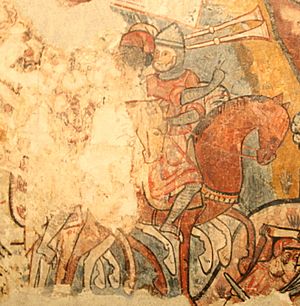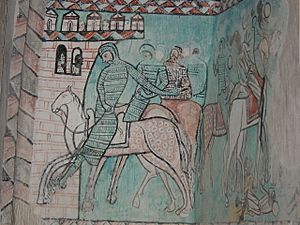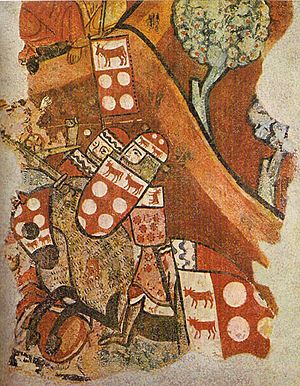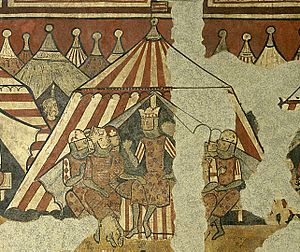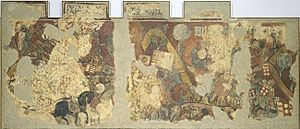Mural paintings of the conquest of Majorca facts for kids
Quick facts for kids Mural paintings of the Conquest of Majorca |
|
|---|---|
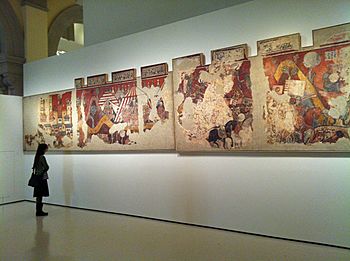 |
|
| Artist | Unknown |
| Year | 1285–1290 |
| Type | Fresco transferred to canvas |
| Dimensions | 178.2 cm × 530.5 cm (70.2 in × 208.9 in); 182.3 cm × 425.8 cm (71.8 in × 167.6 in); 153.6 cm × 412.4 cm (60.5 in × 162.4 in) |
| Location | Museu Nacional d'Art de Catalunya, Barcelona |
The Mural paintings of the Conquest of Majorca are a collection of old paintings from the Gothic period. They were made between 1285 and 1290. Today, you can see them at the National Art Museum of Catalonia in Barcelona, Spain.
These paintings show an important historical event. They tell the story of how King James I the Conqueror took over the island of Majorca in 1229. It's like a painted history book!
Contents
What are these paintings about?
These amazing wall paintings were found in an old family home in Barcelona. This building is now known as Palau Aguilar. It even hosts the Museu Picasso today.
The paintings were discovered and moved in 1961. They are a great example of early Gothic painting from Catalonia. They show the story of the Conquest of Majorca. This was when King James I conquered the island in 1229.
The paintings follow stories from old Catalan books. These include King James I's own book, 'Llibre dels Feits'. They also use parts of Bernat Desclot's Crònica.
Where were these paintings made?
Around the time these paintings were made, a group of artists started working in Barcelona. They painted frescoes on the walls of different palaces. Frescoes are paintings done on wet plaster.
Important works from this group include paintings at Tinell Hall. There are also paintings at the Royal Palace (Palau Reial Mayor). And, of course, the ones from Palau Aguilar.
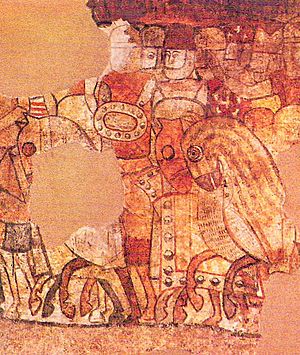
This group of artists likely worked for kings and nobles. They also painted for religious leaders in Barcelona and Majorca. Their style is similar to other artworks from that time. These include altarpieces in Majorca.
Historians believe the king and nobles first asked for these murals in Barcelona. Later, religious leaders in Majorca asked for similar works. Some experts think the artists went to Majorca around 1300.
Similar murals can be found across Spain. For example, paintings in the Monastery of Santa Maria de Valbuena in Valladolid. These show the Conquest of Arjona in 1244.
The Story of the Conquest
The paintings tell the story of the conquest of Majorca in 1229. They are based on two important Catalan history books. These are the Llibre dels Feits and the Chronicle of Bernat Desclot.
Bernat Desclot's book was finished around the same time the murals were painted. He was an official in the Royal Court then.
How Majorca was Conquered
In November 1228, important Catalan leaders met. They were led by King James I. They gathered in Tarragona to plan the conquest of Majorca.
On December 23, 1228, a big meeting happened in Barcelona. After three days, they agreed to the plan. The next year, on September 5, 1229, Catalan ships sailed. They left from Salou, Cambrils, and Tarragona. Their goal was to land at Santa Ponsa.
Just one week later, on September 12, the Moors were defeated. This happened during the Battle of Portopí.
On December 31, after three months of fighting, Catalan troops took over Madina Mayurqa. King James I of Aragon led this attack. It ended the power of the Almohads on the island. The local people were enslaved. Then, Christians were brought in to live there. This led to the creation of the Kingdom of Majorca.
Palau Aguilar: The Home of the Paintings
The palace where these paintings were found was built in the late 1200s. A merchant named Bernat de Caldes built it. It was first called 'Palau de Caldes'.
It is located at 15 Montcada Street in Barcelona. This area was an important part of the old city. It was near the Santa Maria del Mar church.
In the same room where the murals were found, a pot was kept. It showed the family symbol of the owners. When new families owned the palace, they painted their own symbols on the pot. For example, the Ledó family, who owned it from 1317 to 1335, painted a lily and a rose.
The building belonged to several noble families. In 1386, the Coromines-Desplà family bought it. They later sold it to Joan Berenguer d’Aguilar. That's how it got its current name, Palau Aguilar.
The palace became city property in 1953. In 1961, during its restoration, the murals were discovered. They were found in a room near the central courtyard. The palace was being prepared to become the Picasso Museum.
What the Paintings Show
The three large paintings are now at the MNAC museum. They were moved to canvas to help preserve them. They are in a style called 'linear gothic'. They were painted between 1285 and 1290.
They were restored in 1961. Even though some parts are missing, we can still see three main scenes. These are 'the meeting of the Counts of Barcelona', 'the Battle of Porto Pi', and the 'Royal Camp and assault on the city of Majorca'.
The paintings have a realistic feel. The backgrounds show landscapes, not just flat colors. The artists also tried to show feelings in the faces of the people. They even tried to paint portraits. This shows a new style of painting from France.
The first painting, from left to right, shows the 'Courts of Barcelona'. You can see the walls of Barcelona and the cathedral bell tower. A group of people are shown. This probably represents the meeting in December 1228. They met to plan the attack on Majorca.
There are also small pieces of a painting that might show a naval battle.
The second painting shows the 'Battle of Porto Pi'. On September 11, 1229, King James I placed his troops in Santa Ponsa Bay. That same day, the big battle against the Muslims happened at Portopí. The background shows mountains and trees. In the mountains, you can see a group of Moors. In the front, the battle is happening.
In this battle, Guillem II de Montcada i de Bearn died. He is shown riding his horse. He holds a sword and a shield. His family symbols are on his shield and his horse's caparison. Another knight is chasing him towards the Saracen troops. This matches the story told by Bernat Desclot.
The last painting shows the 'Royal Camp and the attack on the city of Majorca'. The camp is on the right side. You can see the royal tent, which is yellow and red. King James I is in the front. He is in the middle of a group of knights.
To his left are three important people. One of them is Nunó Sanç, count of Roselló. To the right, King Guilabert de Cruïlles is shown. He wears a red helmet with a white cross. His hand rests on King James I's knee. The bishop of Barcelona is to Guilabert's right. He wears his special hat, called a mitre. Next to him is the knight Ramon de Centells.
To the left of the King's tent, there is another tent with red stripes. This belongs to Count Hug V d’Empúries. He is talking with the Aragonese knight Pero Maça de Sangarrén. They are shown away from the King's group. This is because the Count d’Empúries disagreed with King James I.
The artists filled the spaces between the tents with more tents. This makes it look like a huge army camp.
The attack on Medina Mayurqa is shown below the royal tent. You can see a large war machine, like a trebuchet. Next to it, soldiers are heading towards the city. They are fighting with a group of Saracens.
A wall with towers surrounds the city. Inside, there are many houses. In the center, you can see the castle of Almundaina. It is protected by two walls.
The tower closest to the camp is being attacked by two men. They carry the Royal crest. They are fighting two Moors. Other towers in the distance are still being defended by the Saracens.
Art Style
These paintings are a type of historical art. They show military events and heroic actions. A similar painting from the same time is in the MNAC. It shows the siege of Girona in 1285. This event was also described by Bernat Desclot. This painting might have been made by the same artist as the Conquest of Majorca murals.
Later, in the early 1300s, other similar paintings appeared. For example, in the castle of Alcanyís. These show King James I conquering Valencia.
The style of these paintings is very similar to those in the Palau Reial Major. Both were made between 1285 and 1290. Both use mostly red, blue, black, and ochre colors. They also have strong black lines.
The story in the paintings is told from right to left. This is the opposite of how it's written in books. But the story matches well.
Historians are not sure which set of paintings was made first. Was it the ones in Palau Reial Major or Palau Aguilar?
The Palau Reial Major paintings might have been first. Their style is more grand and epic. The figures look more solid than those in Palau Aguilar.
The Palau Aguilar paintings show more artistic freedom. Perhaps this style was not suitable for a royal reception hall.
It was discovered that Dolçe de Caldes, daughter of Bernat de Caldes (owner of Palau Aguilar), was expecting King Alfonso the Candid's child. Before he died in 1291, the King asked his brother James (who would become King James the Just) to care for Dolçe and their child. This might explain why both palaces had similar murals.
Meaning in Art
In the 1200s, many artworks told stories of battles or legends. For example, stories about Lancelot by Chrétien de Troyes. Fresco paintings also decorated palaces of knights. These knights wanted their brave deeds to be remembered forever.
In Barcelona, there is a painting about the battle of William the Orange. Another example is a mural in Siena, Italy. It shows Captain Guidoricco da Fogliano conquering a city. This famous work was created by Simone Martini.
See also
 In Spanish: Pinturas murales de la conquista de Mallorca para niños
In Spanish: Pinturas murales de la conquista de Mallorca para niños


